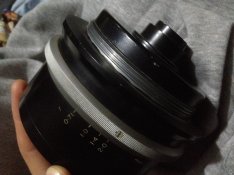jzknight
Member
- Joined
- Mar 23, 2015
- Messages
- 2
- Format
- 35mm
Hi,
I found this huge lens whilst clearing out a loft, I was just wondering if any bright spark could help me indentify what this lens actually is? I am presuming it is not a photography lens? It has an apature ring but no focussing ring. I was thinking it was for a telescope? I have looked online but cant find any information. Not sure if this is the right place to post such a question but just thought I would on the off chance. If there is a better place to post this question please point it out to me.
Any help finding out what this lens actually is would be greatly appreciated.
Many Thanks
Joe


I found this huge lens whilst clearing out a loft, I was just wondering if any bright spark could help me indentify what this lens actually is? I am presuming it is not a photography lens? It has an apature ring but no focussing ring. I was thinking it was for a telescope? I have looked online but cant find any information. Not sure if this is the right place to post such a question but just thought I would on the off chance. If there is a better place to post this question please point it out to me.
Any help finding out what this lens actually is would be greatly appreciated.
Many Thanks
Joe











 ! Can this be used on some large format camera (I'm guessing it has big coverage)? It would be interesting to see the results.
! Can this be used on some large format camera (I'm guessing it has big coverage)? It would be interesting to see the results. $$$$
$$$$

